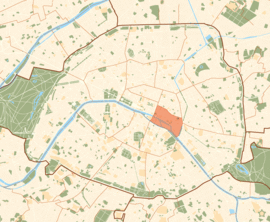4th arrondissement of Paris | |
|---|---|
 Notre-Dame, on the Île de la Cité | |
 Location within Paris | |
| Coordinates: 48°51′20″N 2°21′20″E / 48.85556°N 2.35556°E | |
| Country | France |
| Region | Île-de-France |
| Department | Paris |
| Commune | Paris |
| Government | |
| • Mayor (2020–2026) | Ariel Weil (PS) |
| Area | 1.60 km2 (0.62 sq mi) |
| Population (2021)[1] | 28,324 |
| • Density | 17,703/km2 (45,850/sq mi) |
| INSEE code | 75104 |
 20 arrondissements of Paris | |||||||||||||||||||||||||||||||||||||
|---|---|---|---|---|---|---|---|---|---|---|---|---|---|---|---|---|---|---|---|---|---|---|---|---|---|---|---|---|---|---|---|---|---|---|---|---|---|
|
|||||||||||||||||||||||||||||||||||||
The 4th arrondissement of Paris (IVe arrondissement) is one of the twenty arrondissements of the capital city of France. In spoken French, this arrondissement is referred to as quatrième. Along with the 1st, 2nd and 3rd arrondissements, it is in the first sector of Paris, which maintains a single local government rather than four separate ones.
The arrondissement, also known as Hôtel-de-Ville, is situated on the right bank of the River Seine. It contains the Renaissance-era Paris City Hall, rebuilt between 1874 and 1882.[2] It also contains the Renaissance square of Place des Vosges, the overtly modern Pompidou Centre, and the lively southern part of the medieval district of Le Marais, which today is known for being the gay district of Paris. (The quieter northern part of Le Marais is within the 3rd arrondissement). The eastern part of the Île de la Cité (including Notre-Dame de Paris) and all of the Île Saint-Louis are also included within the 4th arrondissement.
The 4th arrondissement is known for its little streets, cafés, and shops but is often regarded by Parisians as expensive and congested.[citation needed] It has old buildings and a mix of many cultures.
- ^ "Populations légales 2021" (in French). The National Institute of Statistics and Economic Studies. 28 December 2023.
- ^ "Hotel de Ville, the Paris City Hall". Paris Digest. 2018. Archived from the original on 2019-09-24. Retrieved 2018-11-20.
